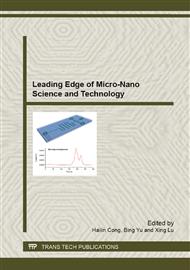[1]
Zhang S X, Francisco J, Lopez, Jerome K. Hyun, et al. Direct detection of hole gas in Ge−Si core−shell nanowires by enhanced Raman scattering, Nano lett. 10 (2010) 4483-4487.
DOI: 10.1021/nl102316b
Google Scholar
[2]
Li-Feng Cui, Yuan Yang, Ching-Mei Hsu, et al. Carbon−Silicon core−shell nanowires as high capacity electrode for lithium ion batteries, Nano Lett. 9 (2009) 3370-3374.
DOI: 10.1021/nl901670t
Google Scholar
[3]
André Müller, Sara E. C. Dale, Miles A. Engbarth, et al. Field-tunable diamagnetism in ferromagnetic–superconducting core–shellstructures, Adv. Funt. Mater. 21(2011) 1874-1880.
DOI: 10.1002/adfm.201100063
Google Scholar
[4]
Gai S H, Yang P P , Li C X , Synthesis of magnetic, up-conversion luminescent, and mesoporous core–shell-structured nanocomposites as drug carriers, Adv. Funct. Mater. 20 (2010) 1166-1172.
DOI: 10.1002/adfm.200902274
Google Scholar
[5]
Yin Y D, Lu Y, Sun Y G, et al. Silver nanowires can be directly coated with amorphous silica to generate well -controlled coaxial nanocables of silver/silica, Nano lett. 2 (2002) 427-430.
DOI: 10.1021/nl025508+
Google Scholar
[6]
Song X C, Zhao Y, Zheng Y F, et al. Fabrication of Ag/C coaxial nanocables with cross-linked structure by SDS-assisted hydrothermal approach, Cryst. Growth Des. 8 (2008) 1823-1826.
DOI: 10.1021/cg700761e
Google Scholar
[7]
Luo L B, Yu S H, Qian S H, et al. Large-scale fabrication of flexible silver/cross-linked poly(vinyl alcohol) coaxial nanocables by a facile solution approach, J. Am. Chem. Soc. 12 (2005) 2822-2823.
DOI: 10.1021/ja0428154
Google Scholar
[8]
Yu S H, Cui X J, Li L L, et al. From starch to metal/carbon hybrid nanostructures: hydrothermal metal-catalyzed carbonization, Adv. Mater. 16 (2004) 1636-1640.
DOI: 10.1002/adma.200400522
Google Scholar
[9]
Fang Z, Tang K B, Lei S J, et al. CTAB-assisted hydrothermal synthesis of Ag/C Nanostructures, Nanotechnology. 17 (2006) 3008–3011.
DOI: 10.1088/0957-4484/17/12/032
Google Scholar
[10]
Wu S Y, Ding Y S, Zhang X M, et al. Structure and morphology controllable synthesis of Ag/carbon hybrid with ionic liquid as soft-template and their catalytic properties. Journal of Solid State Chemistry. 181 (2008) 2171– 2177.
DOI: 10.1016/j.jssc.2008.05.006
Google Scholar


